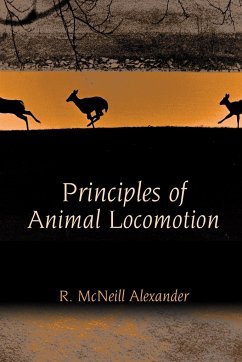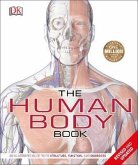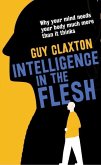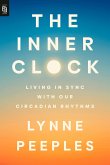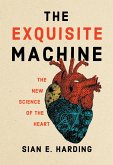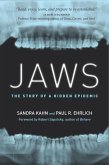R. McNeill Alexander
Principles of Animal Locomotion
R. McNeill Alexander
Principles of Animal Locomotion
- Broschiertes Buch
- Merkliste
- Auf die Merkliste
- Bewerten Bewerten
- Teilen
- Produkt teilen
- Produkterinnerung
- Produkterinnerung
Provides an overview of how animals run, walk, jump, crawl, swim, soar, hover, and fly. This book introduces energetics and optimality as basic principles. It tackles each of the major modes by which animals move on land, in water, and through air. It explains the mechanisms involved and the physical and biological forces shaping those mechanisms.
Andere Kunden interessierten sich auch für
![The Master and His Emissary The Master and His Emissary]() Iain McGilchristThe Master and His Emissary22,99 €
Iain McGilchristThe Master and His Emissary22,99 €![The Human Body Book The Human Body Book]() Richard WalkerThe Human Body Book25,99 €
Richard WalkerThe Human Body Book25,99 €![Intelligence in the Flesh Intelligence in the Flesh]() Guy ClaxtonIntelligence in the Flesh26,99 €
Guy ClaxtonIntelligence in the Flesh26,99 €![The Inner Clock The Inner Clock]() Lynne PeeplesThe Inner Clock14,99 €
Lynne PeeplesThe Inner Clock14,99 €![The Forgotten Sense The Forgotten Sense]() Jonas OlofssonThe Forgotten Sense20,99 €
Jonas OlofssonThe Forgotten Sense20,99 €![The Exquisite Machine The Exquisite Machine]() Sian E. HardingThe Exquisite Machine18,99 €
Sian E. HardingThe Exquisite Machine18,99 €![Jaws Jaws]() Sandra KahnJaws26,99 €
Sandra KahnJaws26,99 €-
-
-
Provides an overview of how animals run, walk, jump, crawl, swim, soar, hover, and fly. This book introduces energetics and optimality as basic principles. It tackles each of the major modes by which animals move on land, in water, and through air. It explains the mechanisms involved and the physical and biological forces shaping those mechanisms.
Hinweis: Dieser Artikel kann nur an eine deutsche Lieferadresse ausgeliefert werden.
Hinweis: Dieser Artikel kann nur an eine deutsche Lieferadresse ausgeliefert werden.
Produktdetails
- Produktdetails
- Verlag: Princeton University Press
- Seitenzahl: 384
- Erscheinungstermin: 19. März 2006
- Englisch
- Abmessung: 234mm x 156mm x 21mm
- Gewicht: 594g
- ISBN-13: 9780691126340
- ISBN-10: 0691126348
- Artikelnr.: 22212745
- Herstellerkennzeichnung
- Libri GmbH
- Europaallee 1
- 36244 Bad Hersfeld
- gpsr@libri.de
- Verlag: Princeton University Press
- Seitenzahl: 384
- Erscheinungstermin: 19. März 2006
- Englisch
- Abmessung: 234mm x 156mm x 21mm
- Gewicht: 594g
- ISBN-13: 9780691126340
- ISBN-10: 0691126348
- Artikelnr.: 22212745
- Herstellerkennzeichnung
- Libri GmbH
- Europaallee 1
- 36244 Bad Hersfeld
- gpsr@libri.de
R. McNeill Alexander
PREFACE ix
Chapter 1: The Best Way to Travel 1
1.1. Fitness 1
1.2. Speed 2
1.3. Acceleration and Maneuverability 2
1.4. Endurance 4
1.5. Economy of Energy 7
1.6. Stability 8
1.7. Compromises 9
1.8. Constraints 9
1.9. Optimization Theory 10
1.10. Gaits 12
Chapter 2: Muscle, the Motor 15
2.1. How Muscles Exert Force 15
2.2. Shortening and Lengthening Muscle 22
2.3. Power Output of Muscles 26
2.4. Pennation Patterns and Moment Arms 28
2.5. Power Consumption 31
2.6. Some Other Types of Muscle 34
Chapter 3: Energy Requirements for Locomotion 38
3.1. Kinetic Energy 38
3.2. Gravitational Potential Energy 39
3.3. Elastic Strain Energy 40
3.4. Work That Does Not Increase the Body's Mechanical Energy 42
3.5. Work Requirements 46
3.6. Oscillatory Movements 48
Chapter 4: Consequences of Size Differences 53
4.1. Geometric Similarity, Allometry, and the Pace of Life 53
4.2. Dynamic Similarity 58
4.3. Elastic Similarity and Stress Similarity 60
Chapter 5: Methods for the Study of Locomotion 68
5.1. Cinematography and Video Recording 68
5.2. Stationary Locomotion 70
5.3. Measurement of Energy Consumption 73
5.4. Observing Flow 74
5.5. Forces and Pressures 76
5.6. Recording Muscle Action 80
5.7. Recording Movement at a Distance 83
5.8. Properties of Materials 84
Chapter 6: Alternative Techniques for Locomotion on Land 86
6.1. Two-Anchor Crawling 86
6.2. Crawling by Peristalsis 88
6.3. Serpentine Crawling 90
6.4. Froglike Hopping 91
6.5. An Inelastic Kangaroo 93
6.6. A Minimal Model of Walking 95
6.7. The Synthetic Wheel 97
6.8. Walkers with Heavy Legs 98
6.9. Spring-Mass Models of Running 99
6.10. Comparisons 100
Chapter 7: Walking, Running, and Hopping 103
7.1. Speed 103
7.2. Gaits 109
7.3. Forces and Energy 114
7.4. Energy-Saving Springs 122
7.5. Internal Kinetic Energy 125
7.6. Metabolic Cost of Transport 128
7.7. Prediction of Optimal Gaits 133
7.8. Soft Ground, Hills, and Loads 136
7.9. Stability 139
7.10. Maneuverability 143
Chapter 8: Climbing and Jumping 146
8.1. Standing Jumps 146
8.2. Leg Design and Jumping Technique 150
8.3. Size and Jumping 153
8.4. Jumping from Branches 155
8.5. Climbing Vertical Surfaces and Walking on the Ceiling 159
Chapter 9: Crawling and Burrowing 166
9.1. Worms 166
9.2. Insect Larvae 170
9.3. Molluscs 171
9.4. Reptiles 176
9.5. Mammals 179
Chapter 10: Gliding and Soaring 181
10.1. Drag 181
10.2. Lift 183
10.3. Drag on Aerofoils 187
10.4. Gliding Performance 192
10.5. Stability 200
10.6. Soaring 201
Chapter 11: Hovering 209
11.1. Airflow around Hovering Animals 209
11.2. Lift Generation 213
11.3. Power for Hovering 221
Chapter 12: Powered Forward Flight 224
12.1. Aerodynamics of Flapping Flight 224
12.2. Power Requirements for Flight 228
12.3. Optimization of Flight 236
Chapter 13: Moving on the Surface of Water 240
13.1. Fisher Spiders 240
13.2. Basilisk Lizards 244
13.3. Surface Swimmers 246
Chapter 14: Swimming with Oars and Hydrofoils 249
14.1. Froude Efficiency 249
14.2. Drag-Powered Swimming 250
14.3. Swimming Powered by Lift on Limbs or Paired Fins 255
14.4. Swimming with Hydrofoil Tails 261
14.5. Porpoising 264
Chapter 15: Swimming by Undulation 266
15.1. Undulating Fishes 266
15.2. Muscle Activity in Undulating Fishes 277
15.3. Fins, Tails, and Gaits 282
15.4. Undulating Worms 284
Chapter 16: Swimming by Jet Propulsion 288
16.1. Efficiency of Jet Propulsion 288
16.2. Elastic Mechanisms in Jet Propulsion 296
Chapter 17: Buoyancy 301
17.1. Buoyancy Organs 301
17.2. Swimming by Dense Animals 303
17.3. Energetics of Buoyancy 307
17.4. Buoyancy and Lifestyle 311
Chapter 18: Aids to Human Locomotion 316
18.1. Shoes 316
18.2. Bicycles 318
18.3. Scuba 321
18.4. Boats 322
18.5. Aircraft without Engines 324
Chapter 19: Epilogue 327
19.1. Metabolic Cost of Transport 327
19.2. Speeds 328
19.3. Gaits 330
19.4. Elastic Mechanisms 331
19.5. Priorities for Further Research 331
REFERENCES 333
INDEX 367
Chapter 1: The Best Way to Travel 1
1.1. Fitness 1
1.2. Speed 2
1.3. Acceleration and Maneuverability 2
1.4. Endurance 4
1.5. Economy of Energy 7
1.6. Stability 8
1.7. Compromises 9
1.8. Constraints 9
1.9. Optimization Theory 10
1.10. Gaits 12
Chapter 2: Muscle, the Motor 15
2.1. How Muscles Exert Force 15
2.2. Shortening and Lengthening Muscle 22
2.3. Power Output of Muscles 26
2.4. Pennation Patterns and Moment Arms 28
2.5. Power Consumption 31
2.6. Some Other Types of Muscle 34
Chapter 3: Energy Requirements for Locomotion 38
3.1. Kinetic Energy 38
3.2. Gravitational Potential Energy 39
3.3. Elastic Strain Energy 40
3.4. Work That Does Not Increase the Body's Mechanical Energy 42
3.5. Work Requirements 46
3.6. Oscillatory Movements 48
Chapter 4: Consequences of Size Differences 53
4.1. Geometric Similarity, Allometry, and the Pace of Life 53
4.2. Dynamic Similarity 58
4.3. Elastic Similarity and Stress Similarity 60
Chapter 5: Methods for the Study of Locomotion 68
5.1. Cinematography and Video Recording 68
5.2. Stationary Locomotion 70
5.3. Measurement of Energy Consumption 73
5.4. Observing Flow 74
5.5. Forces and Pressures 76
5.6. Recording Muscle Action 80
5.7. Recording Movement at a Distance 83
5.8. Properties of Materials 84
Chapter 6: Alternative Techniques for Locomotion on Land 86
6.1. Two-Anchor Crawling 86
6.2. Crawling by Peristalsis 88
6.3. Serpentine Crawling 90
6.4. Froglike Hopping 91
6.5. An Inelastic Kangaroo 93
6.6. A Minimal Model of Walking 95
6.7. The Synthetic Wheel 97
6.8. Walkers with Heavy Legs 98
6.9. Spring-Mass Models of Running 99
6.10. Comparisons 100
Chapter 7: Walking, Running, and Hopping 103
7.1. Speed 103
7.2. Gaits 109
7.3. Forces and Energy 114
7.4. Energy-Saving Springs 122
7.5. Internal Kinetic Energy 125
7.6. Metabolic Cost of Transport 128
7.7. Prediction of Optimal Gaits 133
7.8. Soft Ground, Hills, and Loads 136
7.9. Stability 139
7.10. Maneuverability 143
Chapter 8: Climbing and Jumping 146
8.1. Standing Jumps 146
8.2. Leg Design and Jumping Technique 150
8.3. Size and Jumping 153
8.4. Jumping from Branches 155
8.5. Climbing Vertical Surfaces and Walking on the Ceiling 159
Chapter 9: Crawling and Burrowing 166
9.1. Worms 166
9.2. Insect Larvae 170
9.3. Molluscs 171
9.4. Reptiles 176
9.5. Mammals 179
Chapter 10: Gliding and Soaring 181
10.1. Drag 181
10.2. Lift 183
10.3. Drag on Aerofoils 187
10.4. Gliding Performance 192
10.5. Stability 200
10.6. Soaring 201
Chapter 11: Hovering 209
11.1. Airflow around Hovering Animals 209
11.2. Lift Generation 213
11.3. Power for Hovering 221
Chapter 12: Powered Forward Flight 224
12.1. Aerodynamics of Flapping Flight 224
12.2. Power Requirements for Flight 228
12.3. Optimization of Flight 236
Chapter 13: Moving on the Surface of Water 240
13.1. Fisher Spiders 240
13.2. Basilisk Lizards 244
13.3. Surface Swimmers 246
Chapter 14: Swimming with Oars and Hydrofoils 249
14.1. Froude Efficiency 249
14.2. Drag-Powered Swimming 250
14.3. Swimming Powered by Lift on Limbs or Paired Fins 255
14.4. Swimming with Hydrofoil Tails 261
14.5. Porpoising 264
Chapter 15: Swimming by Undulation 266
15.1. Undulating Fishes 266
15.2. Muscle Activity in Undulating Fishes 277
15.3. Fins, Tails, and Gaits 282
15.4. Undulating Worms 284
Chapter 16: Swimming by Jet Propulsion 288
16.1. Efficiency of Jet Propulsion 288
16.2. Elastic Mechanisms in Jet Propulsion 296
Chapter 17: Buoyancy 301
17.1. Buoyancy Organs 301
17.2. Swimming by Dense Animals 303
17.3. Energetics of Buoyancy 307
17.4. Buoyancy and Lifestyle 311
Chapter 18: Aids to Human Locomotion 316
18.1. Shoes 316
18.2. Bicycles 318
18.3. Scuba 321
18.4. Boats 322
18.5. Aircraft without Engines 324
Chapter 19: Epilogue 327
19.1. Metabolic Cost of Transport 327
19.2. Speeds 328
19.3. Gaits 330
19.4. Elastic Mechanisms 331
19.5. Priorities for Further Research 331
REFERENCES 333
INDEX 367
PREFACE ix
Chapter 1: The Best Way to Travel 1
1.1. Fitness 1
1.2. Speed 2
1.3. Acceleration and Maneuverability 2
1.4. Endurance 4
1.5. Economy of Energy 7
1.6. Stability 8
1.7. Compromises 9
1.8. Constraints 9
1.9. Optimization Theory 10
1.10. Gaits 12
Chapter 2: Muscle, the Motor 15
2.1. How Muscles Exert Force 15
2.2. Shortening and Lengthening Muscle 22
2.3. Power Output of Muscles 26
2.4. Pennation Patterns and Moment Arms 28
2.5. Power Consumption 31
2.6. Some Other Types of Muscle 34
Chapter 3: Energy Requirements for Locomotion 38
3.1. Kinetic Energy 38
3.2. Gravitational Potential Energy 39
3.3. Elastic Strain Energy 40
3.4. Work That Does Not Increase the Body's Mechanical Energy 42
3.5. Work Requirements 46
3.6. Oscillatory Movements 48
Chapter 4: Consequences of Size Differences 53
4.1. Geometric Similarity, Allometry, and the Pace of Life 53
4.2. Dynamic Similarity 58
4.3. Elastic Similarity and Stress Similarity 60
Chapter 5: Methods for the Study of Locomotion 68
5.1. Cinematography and Video Recording 68
5.2. Stationary Locomotion 70
5.3. Measurement of Energy Consumption 73
5.4. Observing Flow 74
5.5. Forces and Pressures 76
5.6. Recording Muscle Action 80
5.7. Recording Movement at a Distance 83
5.8. Properties of Materials 84
Chapter 6: Alternative Techniques for Locomotion on Land 86
6.1. Two-Anchor Crawling 86
6.2. Crawling by Peristalsis 88
6.3. Serpentine Crawling 90
6.4. Froglike Hopping 91
6.5. An Inelastic Kangaroo 93
6.6. A Minimal Model of Walking 95
6.7. The Synthetic Wheel 97
6.8. Walkers with Heavy Legs 98
6.9. Spring-Mass Models of Running 99
6.10. Comparisons 100
Chapter 7: Walking, Running, and Hopping 103
7.1. Speed 103
7.2. Gaits 109
7.3. Forces and Energy 114
7.4. Energy-Saving Springs 122
7.5. Internal Kinetic Energy 125
7.6. Metabolic Cost of Transport 128
7.7. Prediction of Optimal Gaits 133
7.8. Soft Ground, Hills, and Loads 136
7.9. Stability 139
7.10. Maneuverability 143
Chapter 8: Climbing and Jumping 146
8.1. Standing Jumps 146
8.2. Leg Design and Jumping Technique 150
8.3. Size and Jumping 153
8.4. Jumping from Branches 155
8.5. Climbing Vertical Surfaces and Walking on the Ceiling 159
Chapter 9: Crawling and Burrowing 166
9.1. Worms 166
9.2. Insect Larvae 170
9.3. Molluscs 171
9.4. Reptiles 176
9.5. Mammals 179
Chapter 10: Gliding and Soaring 181
10.1. Drag 181
10.2. Lift 183
10.3. Drag on Aerofoils 187
10.4. Gliding Performance 192
10.5. Stability 200
10.6. Soaring 201
Chapter 11: Hovering 209
11.1. Airflow around Hovering Animals 209
11.2. Lift Generation 213
11.3. Power for Hovering 221
Chapter 12: Powered Forward Flight 224
12.1. Aerodynamics of Flapping Flight 224
12.2. Power Requirements for Flight 228
12.3. Optimization of Flight 236
Chapter 13: Moving on the Surface of Water 240
13.1. Fisher Spiders 240
13.2. Basilisk Lizards 244
13.3. Surface Swimmers 246
Chapter 14: Swimming with Oars and Hydrofoils 249
14.1. Froude Efficiency 249
14.2. Drag-Powered Swimming 250
14.3. Swimming Powered by Lift on Limbs or Paired Fins 255
14.4. Swimming with Hydrofoil Tails 261
14.5. Porpoising 264
Chapter 15: Swimming by Undulation 266
15.1. Undulating Fishes 266
15.2. Muscle Activity in Undulating Fishes 277
15.3. Fins, Tails, and Gaits 282
15.4. Undulating Worms 284
Chapter 16: Swimming by Jet Propulsion 288
16.1. Efficiency of Jet Propulsion 288
16.2. Elastic Mechanisms in Jet Propulsion 296
Chapter 17: Buoyancy 301
17.1. Buoyancy Organs 301
17.2. Swimming by Dense Animals 303
17.3. Energetics of Buoyancy 307
17.4. Buoyancy and Lifestyle 311
Chapter 18: Aids to Human Locomotion 316
18.1. Shoes 316
18.2. Bicycles 318
18.3. Scuba 321
18.4. Boats 322
18.5. Aircraft without Engines 324
Chapter 19: Epilogue 327
19.1. Metabolic Cost of Transport 327
19.2. Speeds 328
19.3. Gaits 330
19.4. Elastic Mechanisms 331
19.5. Priorities for Further Research 331
REFERENCES 333
INDEX 367
Chapter 1: The Best Way to Travel 1
1.1. Fitness 1
1.2. Speed 2
1.3. Acceleration and Maneuverability 2
1.4. Endurance 4
1.5. Economy of Energy 7
1.6. Stability 8
1.7. Compromises 9
1.8. Constraints 9
1.9. Optimization Theory 10
1.10. Gaits 12
Chapter 2: Muscle, the Motor 15
2.1. How Muscles Exert Force 15
2.2. Shortening and Lengthening Muscle 22
2.3. Power Output of Muscles 26
2.4. Pennation Patterns and Moment Arms 28
2.5. Power Consumption 31
2.6. Some Other Types of Muscle 34
Chapter 3: Energy Requirements for Locomotion 38
3.1. Kinetic Energy 38
3.2. Gravitational Potential Energy 39
3.3. Elastic Strain Energy 40
3.4. Work That Does Not Increase the Body's Mechanical Energy 42
3.5. Work Requirements 46
3.6. Oscillatory Movements 48
Chapter 4: Consequences of Size Differences 53
4.1. Geometric Similarity, Allometry, and the Pace of Life 53
4.2. Dynamic Similarity 58
4.3. Elastic Similarity and Stress Similarity 60
Chapter 5: Methods for the Study of Locomotion 68
5.1. Cinematography and Video Recording 68
5.2. Stationary Locomotion 70
5.3. Measurement of Energy Consumption 73
5.4. Observing Flow 74
5.5. Forces and Pressures 76
5.6. Recording Muscle Action 80
5.7. Recording Movement at a Distance 83
5.8. Properties of Materials 84
Chapter 6: Alternative Techniques for Locomotion on Land 86
6.1. Two-Anchor Crawling 86
6.2. Crawling by Peristalsis 88
6.3. Serpentine Crawling 90
6.4. Froglike Hopping 91
6.5. An Inelastic Kangaroo 93
6.6. A Minimal Model of Walking 95
6.7. The Synthetic Wheel 97
6.8. Walkers with Heavy Legs 98
6.9. Spring-Mass Models of Running 99
6.10. Comparisons 100
Chapter 7: Walking, Running, and Hopping 103
7.1. Speed 103
7.2. Gaits 109
7.3. Forces and Energy 114
7.4. Energy-Saving Springs 122
7.5. Internal Kinetic Energy 125
7.6. Metabolic Cost of Transport 128
7.7. Prediction of Optimal Gaits 133
7.8. Soft Ground, Hills, and Loads 136
7.9. Stability 139
7.10. Maneuverability 143
Chapter 8: Climbing and Jumping 146
8.1. Standing Jumps 146
8.2. Leg Design and Jumping Technique 150
8.3. Size and Jumping 153
8.4. Jumping from Branches 155
8.5. Climbing Vertical Surfaces and Walking on the Ceiling 159
Chapter 9: Crawling and Burrowing 166
9.1. Worms 166
9.2. Insect Larvae 170
9.3. Molluscs 171
9.4. Reptiles 176
9.5. Mammals 179
Chapter 10: Gliding and Soaring 181
10.1. Drag 181
10.2. Lift 183
10.3. Drag on Aerofoils 187
10.4. Gliding Performance 192
10.5. Stability 200
10.6. Soaring 201
Chapter 11: Hovering 209
11.1. Airflow around Hovering Animals 209
11.2. Lift Generation 213
11.3. Power for Hovering 221
Chapter 12: Powered Forward Flight 224
12.1. Aerodynamics of Flapping Flight 224
12.2. Power Requirements for Flight 228
12.3. Optimization of Flight 236
Chapter 13: Moving on the Surface of Water 240
13.1. Fisher Spiders 240
13.2. Basilisk Lizards 244
13.3. Surface Swimmers 246
Chapter 14: Swimming with Oars and Hydrofoils 249
14.1. Froude Efficiency 249
14.2. Drag-Powered Swimming 250
14.3. Swimming Powered by Lift on Limbs or Paired Fins 255
14.4. Swimming with Hydrofoil Tails 261
14.5. Porpoising 264
Chapter 15: Swimming by Undulation 266
15.1. Undulating Fishes 266
15.2. Muscle Activity in Undulating Fishes 277
15.3. Fins, Tails, and Gaits 282
15.4. Undulating Worms 284
Chapter 16: Swimming by Jet Propulsion 288
16.1. Efficiency of Jet Propulsion 288
16.2. Elastic Mechanisms in Jet Propulsion 296
Chapter 17: Buoyancy 301
17.1. Buoyancy Organs 301
17.2. Swimming by Dense Animals 303
17.3. Energetics of Buoyancy 307
17.4. Buoyancy and Lifestyle 311
Chapter 18: Aids to Human Locomotion 316
18.1. Shoes 316
18.2. Bicycles 318
18.3. Scuba 321
18.4. Boats 322
18.5. Aircraft without Engines 324
Chapter 19: Epilogue 327
19.1. Metabolic Cost of Transport 327
19.2. Speeds 328
19.3. Gaits 330
19.4. Elastic Mechanisms 331
19.5. Priorities for Further Research 331
REFERENCES 333
INDEX 367

